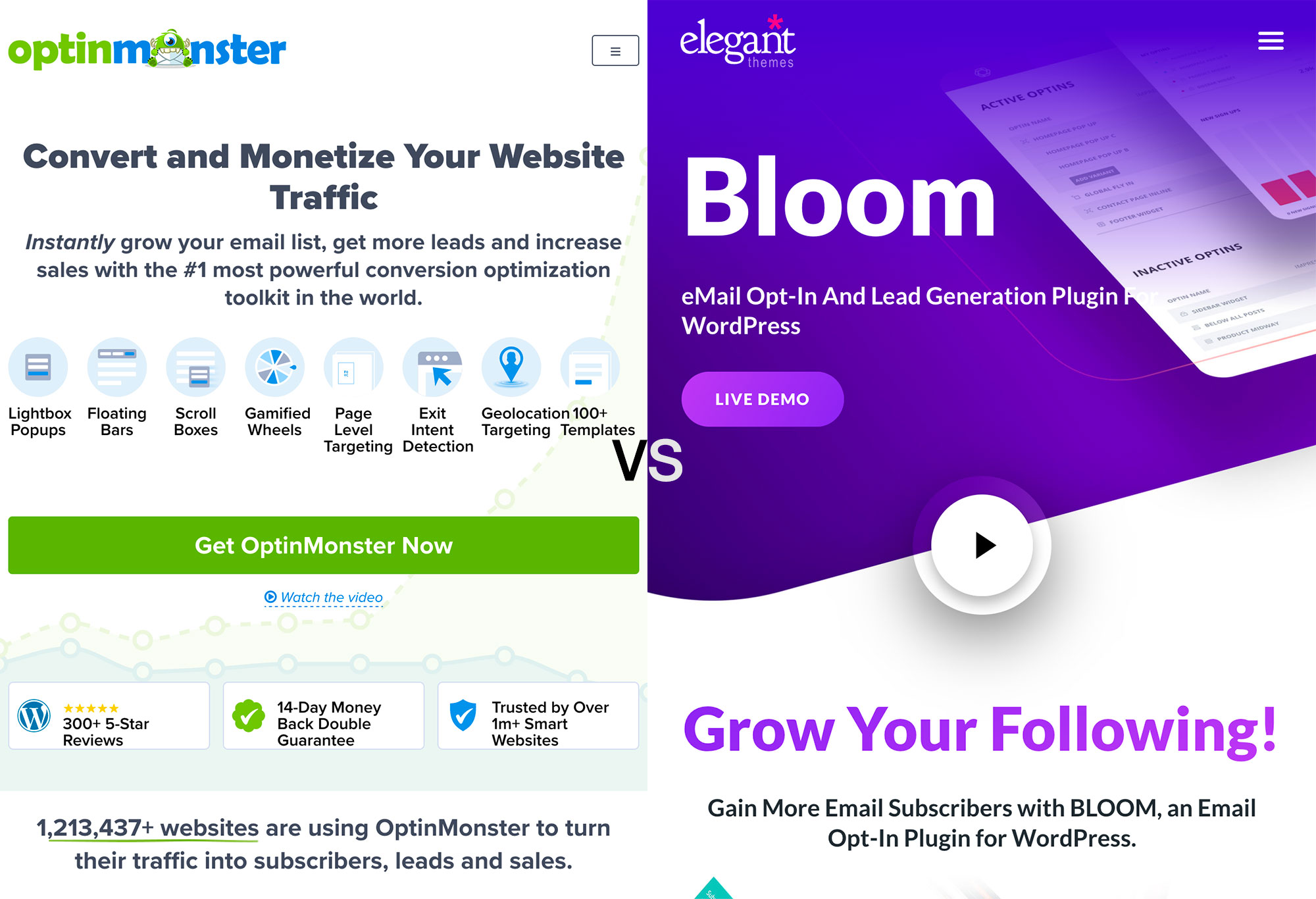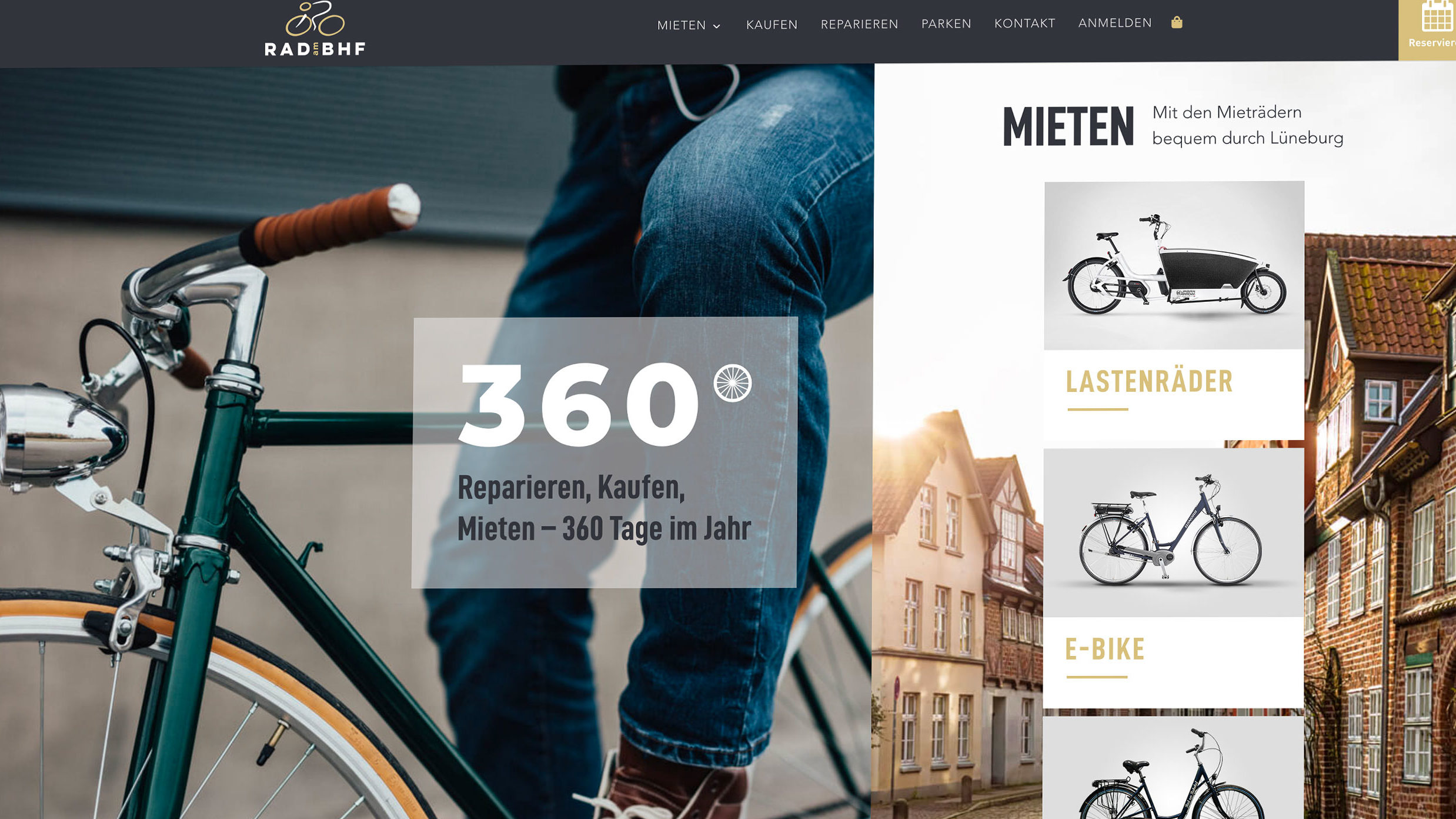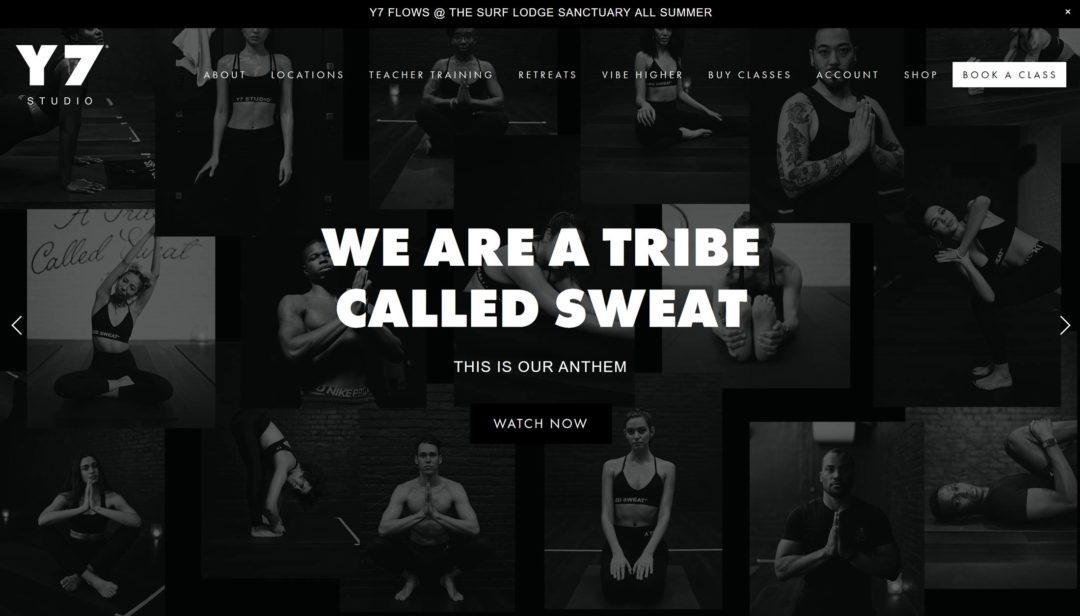Debating between OptinMonster vs Bloom to create opt-ins and promos on your WordPress site?
Both of these tools help you to grow your email lists using popups and other types of opt-in forms, but they have pretty different feature sets and price points, so you’ll want to make sure you’re choosing the best tool for your needs and budget.
In general, OptinMonster is best for serious marketers who are willing to invest in a tool and need advanced targeting and personalization options, while Bloom is a better option for webmasters who are just looking for a simple solution to create some great-looking opt-in forms on a budget (especially if you’re also interested in the Divi theme).
To help you to understand how I came to those conclusions, I’ll compare OptinMonster vs Bloom based on seven different categories: Features, Form types, Content editors, Targeting rules, Trigger rules, Integrations, Pricing.
Table of Contents
A Quick Introduction to OptinMonster and Bloom
To kick off this comparison, let’s quickly run over the basics of both of these tools.
OptinMonster
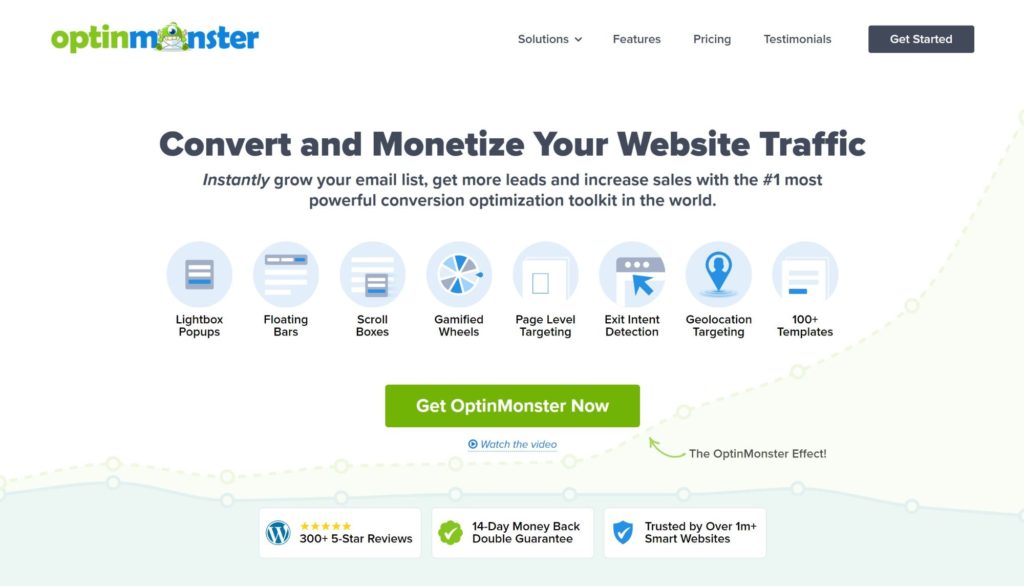
OptinMonster started as a native WordPress plugin before morphing into a standalone SaaS tool that you can use with any website building platform. With that being said, it comes from the same team behind a number of popular WordPress plugins, including WPForms, MonsterInsights, All In One SEO, and more.
True to its WordPress roots, OptinMonster still maintains a dedicated WordPress integration plugin that makes it easy to connect your opt-in forms to WordPress. The plugin also unlocks some WordPress-specific features, such as targeting your forms to specific WordPress categories/tags and users.
However, the downside of this SaaS approach is that OptinMonster uses recurring SaaS billing — that is, you’ll need to continue to pay for as long as you want to use the tool, which is different from how most WordPress plugins are one-time fees where you only need to renew to continue receiving support/updates.
It’s also just generally more expensive than the native WordPress plugins you may be used to.
Bloom
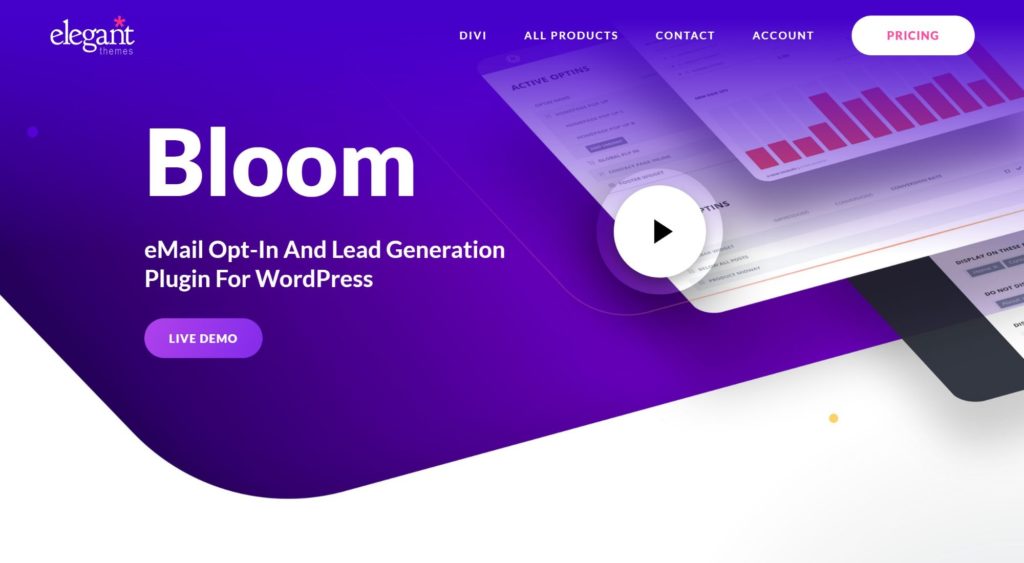
Bloom is a native WordPress plugin that’s part of the Elegant Themes membership. If you’re not familiar with Elegant Themes, it’s the same developer behind the massively popular Divi theme and page builder plugin.
One unique thing about Bloom is you can’t purchase it by itself. Instead, it’s part of the Elegant Themes membership, which gets you access to all of the Elegant Themes plugins and themes, including Divi, for one low price.
This means Bloom is best if you’re into the Elegant Themes ecosystem and planning to use other Elegant Themes products, such as the Divi theme. However, you can use Bloom with any WordPress theme, so it’s definitely not limited to Divi users. And, even if you only purchase the Elegant Themes membership for Bloom, it can still work out to be a lot cheaper than OptinMonster.
Features
I’ll dig into some of the specific features in more depth, but I think it’s useful to start with a simple comparison table, so you can get a high-level look at how these tools compare:
| OptinMonster | Bloom | |
|---|---|---|
| Opt-in popups | ✔️ | ✔️ |
| Inline opt-in forms | ✔️ | ✔️ |
| Two-step opt-ins | ✔️ | ❌ |
| Pre-made templates | ✔️ | ✔️ |
| Drag-and-drop editor | ✔️ | ❌ |
| Content-specific targeting rules | ✔️ | ✔️ |
| User-specific targeting rules | ✔️ | ❌ |
| Multiple trigger rules | ✔️ | ✔️ |
| Integrations | 34+ | 19+ |
| eCommerce features | ✔️ | ❌ |
| Analytics | ✔️ | ✔️ |
| A/B testing | ✔️ | ✔️ |
🏆 Winner: OptinMonster… but it’s close. Simply put, OptinMonster has more features than Bloom. However, Bloom has all of the features most people need, so this is actually a lot closer than you may think.
Form Types
Both tools let you create all of the essential form types, including various types of popups and in-content forms. OptinMonster also throws in a few unique form types that you may or may not use. But, in general, unless you’re going to use one of those unique form types, this is pretty much a tie.
OptinMonster
OptinMonster offers the following core form types:
- Popups
- Slide-ins
- Inline forms
- Sidebar forms (AKA place in a sidebar widget)
- Content locker
Then, here are the form types OptinMonster offers that Bloom doesn’t have:
- Top or bottom notification bar
- Full-screen welcome map
- Gamified spin a wheel popup
OptinMonster also lets you create two-step opt-ins, where a visitor opens a popup by clicking a link/button.
Bloom
Bloom has the following form types:
- Popups
- Fly-ins (AKA slide-ins)
- Inline forms (you can manually place them with a shortcode)
- Below content forms (these automatically appear below your content)
- Widget area forms
- Content locker
To make it easier to see the differences between the two, here’s a quick comparison table:
| OptinMonster | Bloom | |
|---|---|---|
| Popups | ✔️ | ✔️ |
| Inline forms | ✔️ | ✔️ |
| Slide-ins | ✔️ | ✔️ |
| Sidebar/widget area | ✔️ | ✔️ |
| Content locker | ✔️ | ✔️ |
| Notification bar | ✔️ | ❌ |
| Full-screen welcome mat | ✔️ | ❌ |
| Gamified wheel | ✔️ | ❌ |
| Two-step opt-in | ✔️ | ❌ |
🏆 Winner: OptinMonster. However, both tools offer all of the essential form types, so this could easily be a tie if you aren’t planning to use the more niche options, such as welcome mats or spin wheels.
Content Editors & Templates
OptinMonster and Bloom use different approaches to letting you customize the opt-in forms you create. Overall, OptinMonster offers much more customization, while Bloom’s approach is a lot simpler and more straightforward (though less flexible).
Neither approach is inherently better, and you may prefer one or the other depending on your goals.
OptinMonster
When you choose your form type in OptinMonster, it will show a list of pre-made templates that are specific to that form type. Or, you can always start from a blank canvas:
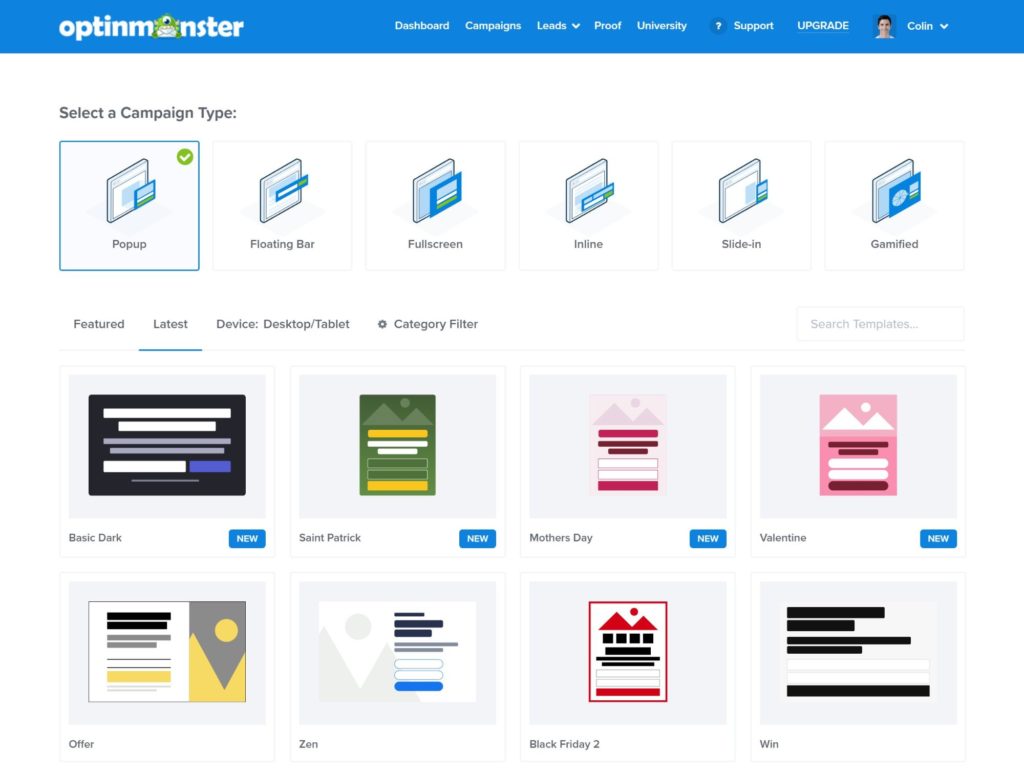
From there, OptinMonster gives you a visual drag-and-drop builder where you can fully customize the template’s content, add new content/design elements, or remove existing elements:
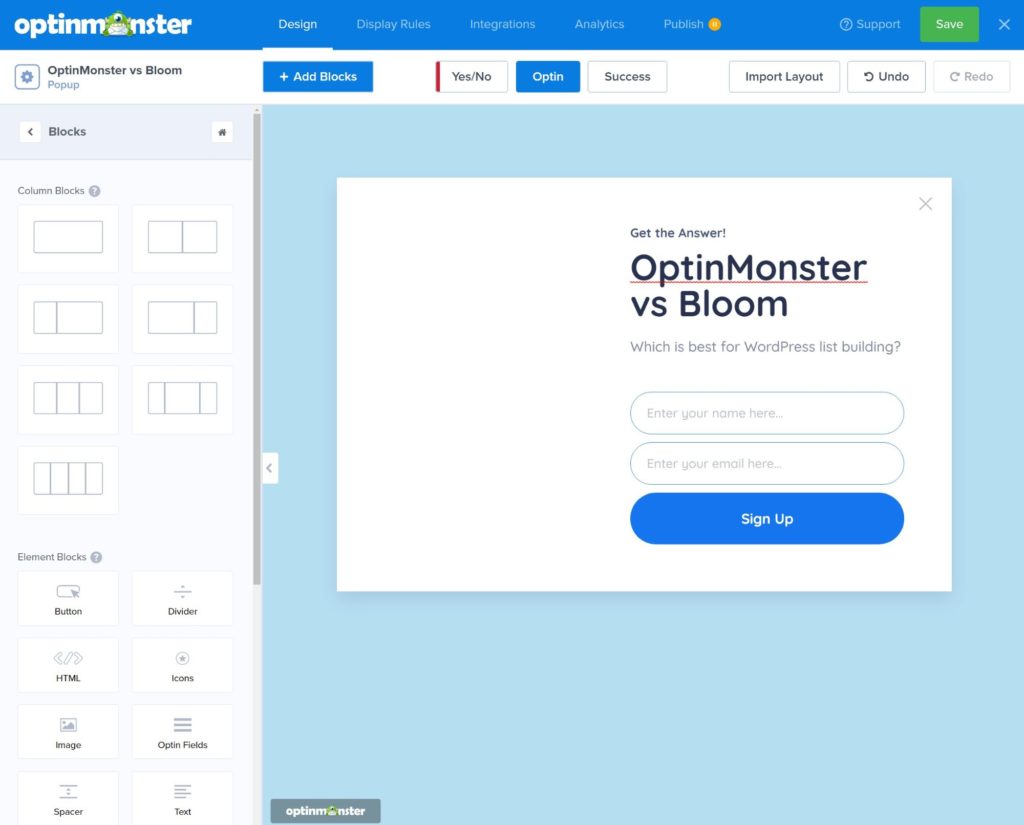
If you’ve ever used a WordPress page builder plugin, OptinMonster’s editor operates on the same basic principles.
The key thing to understand with OptinMonster is that you have pretty much full control over every element in your design. You can add stuff, remove stuff, move stuff around, and so on. This isn’t the case with Bloom.
Bloom
Like OptinMonster, Bloom will show you a list of templates based on the form type you select:
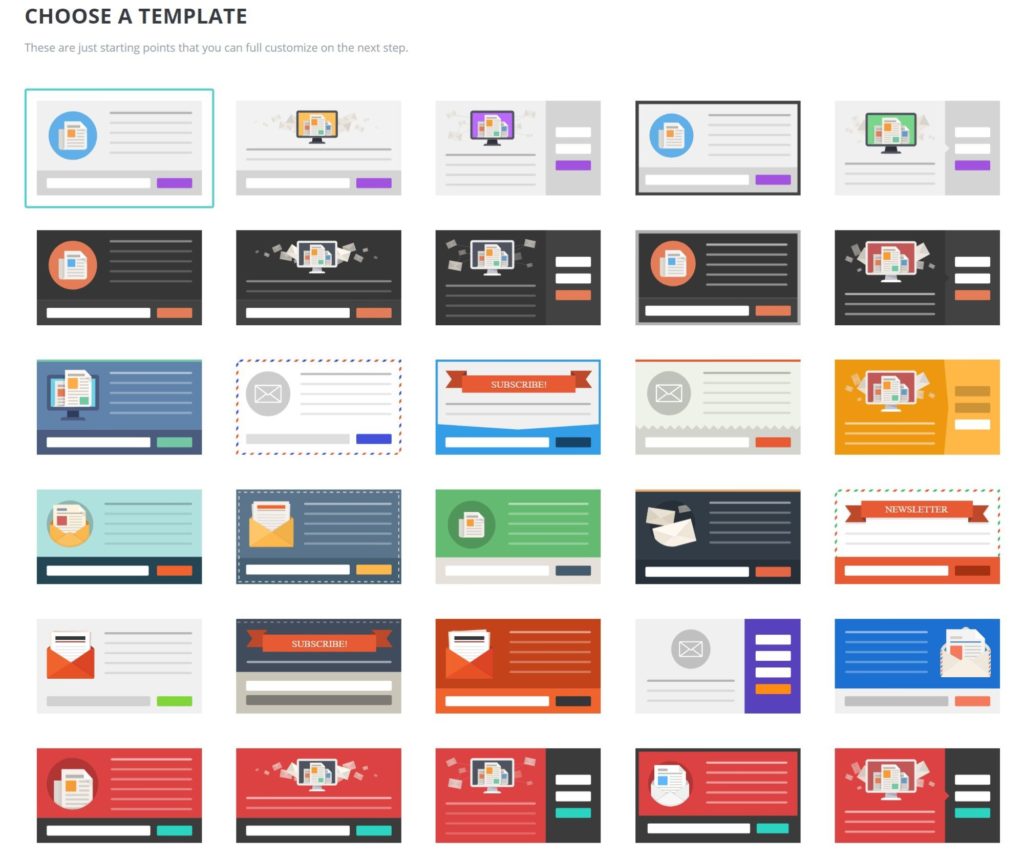
However, unlike OptinMonster, you can’t fully customize these templates with drag-and-drop, nor can you create your own design from scratch. Instead, you can only customize the content/style of the existing template using a settings panel:
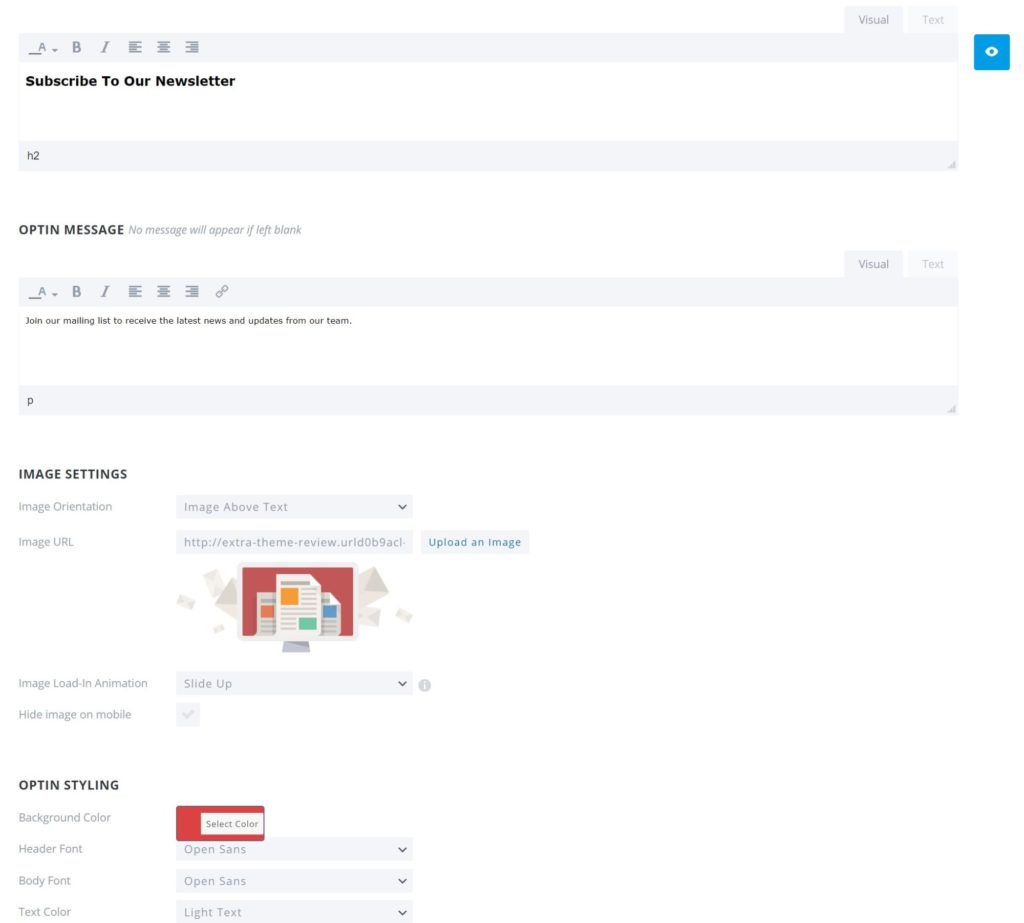
While this definitely doesn’t give you as much design flexibility as OptinMonster, one advantage of this approach is it’s super simple. All you do is choose your base template and swap in your own content and colors, and you have a great-looking opt-in form.
So, if you want something super simple and you like the pre-built templates, you may actually prefer Bloom’s approach.
🏆 Winner: OptinMonster. Thanks to its drag-and-drop builder, OptinMonster gives you more control over your designs and a more flexible editing experience, all while keeping things beginner-friendly.
Targeting Rules
Targeting rules are essential in an opt-in tool because they help to make sure the right people are seeing your forms.
For example, you might display one form to people browsing posts in one category and a different form to people browsing posts in another category. Or, you might display one form for people who are just visiting your site for the first time and another for people who are regular visitors.
In terms of setting up these types of rules, OptinMonster is definitely the winner, because it goes beyond content-level targeting and adds tons of rules to help you to target specific users/types of users.
OptinMonster
At a basic level, OptinMonster offers all of the same content targeting features you get with Bloom. You can target your popups to specific URLs, URL structures (including Regex), and so on.
If you use the official OptinMonster plugin, it also makes it easier to target WordPress-specific content by adding new options to target content by category, tag or post type with the check of a box.
However, OptinMonster goes way beyond content-level targeting and also lets you target your forms by visitor information/behavior:
- Referrer detection — show a form based on where a user came from (i.e. a certain website or search engine). For example, you could create a special offer for people who visited your site from an ad/guest post you placed on another site.
- New vs. returning visitors — show different offers based on whether it’s a person’s first visit to your site or they’re a regular visitor.
- Geolocation — target forms based on a user’s physical location.
- Cookie detection — target an opt-in to users with a specific cookie.
- Previous interaction — show an offer based on how people interacted with a previous offer. For example, show a different offer to someone who already joined your email list via a previous form. This also lets you string together offers to create your own mini funnels.
- Adblock usage — show a special message to people using an adblocker.
With the WordPress plugin, you can also disable popups for logged-in users. Or, with some code snippets, you can target specific WordPress user roles, which is useful if you have a membership site with different levels of users.
Finally, if you have an eCommerce store, you also get some really useful eCommerce-specific rules (the exact rules depend on which eCommerce platform you’re using):
- Products in a user’s cart.
- Total value of a user’s cart.
- Number of items in a user’s cart.
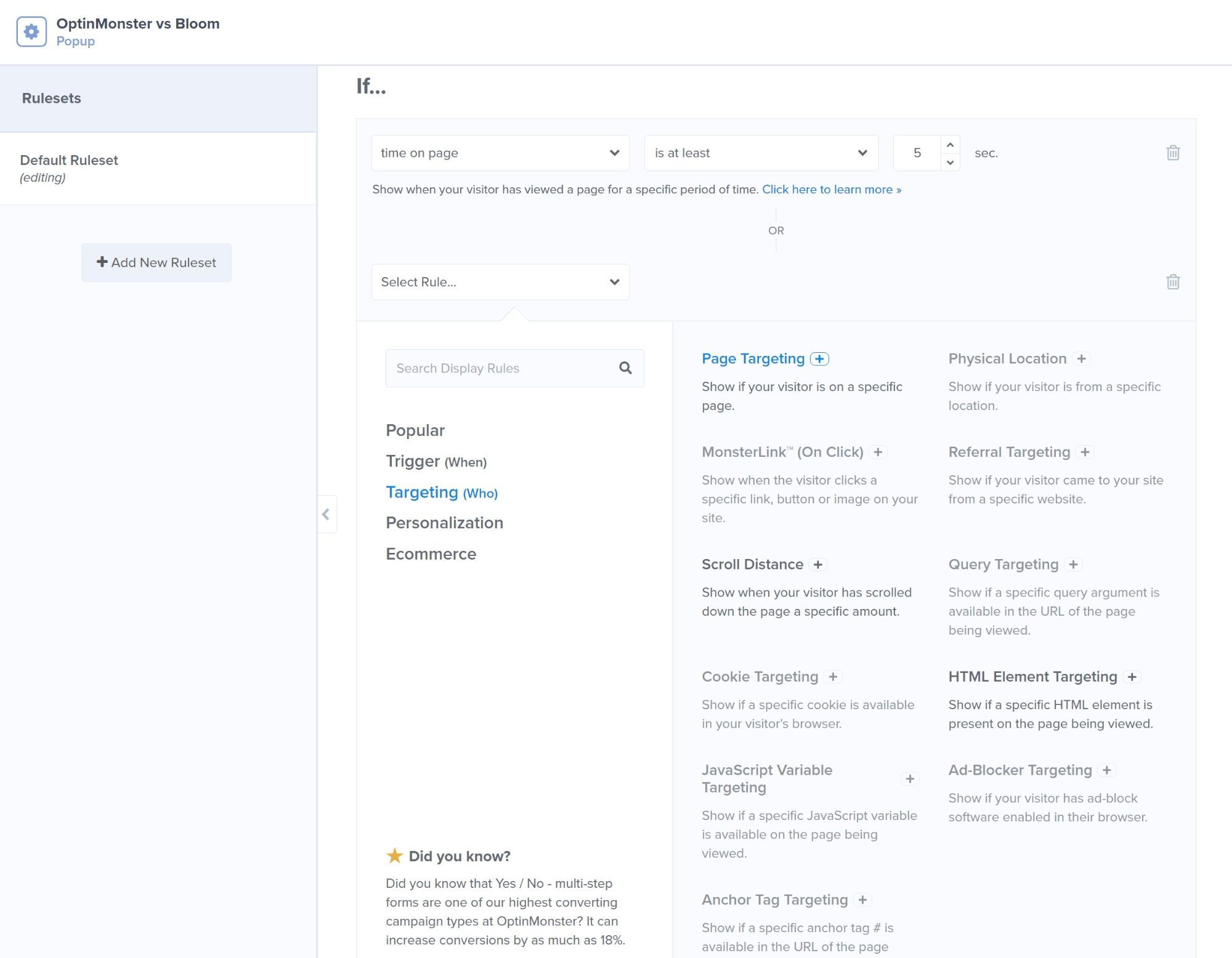
The really powerful thing, though, is that you can mix-and-match all of these rules to create your own custom combinations. For example, you could target returning visitors who are using a desktop device and browsing content in the ‘WordPress’ category.
You can create your own rulesets, with each ruleset including unlimited rules grouped into multiple AND/OR groups. Below, you can see an example of multiple rulesets and multiple AND/OR rules within a ruleset:
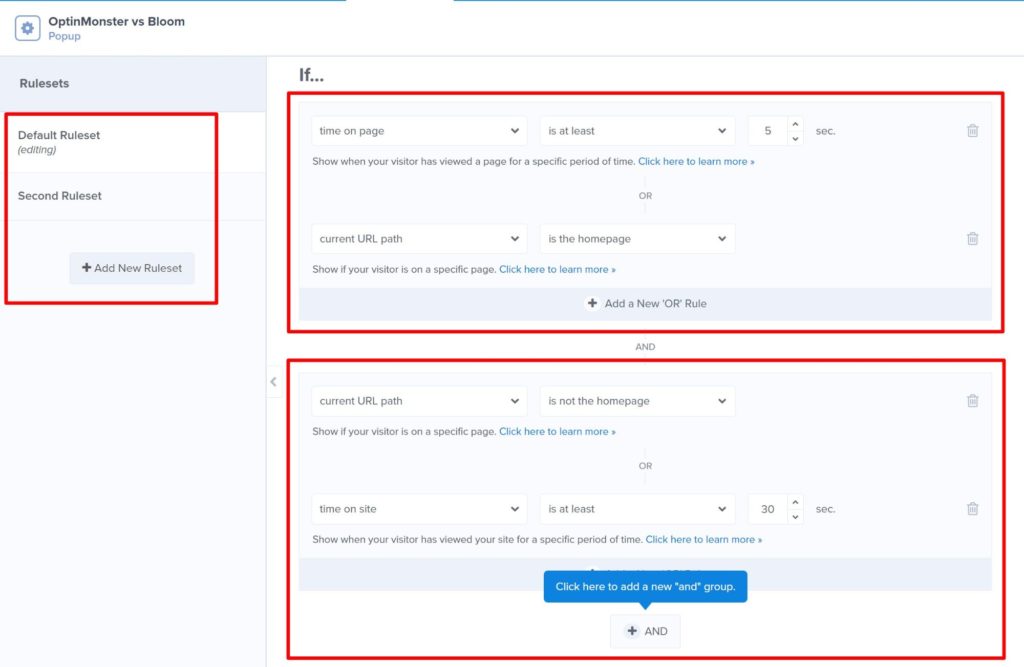
Bloom
Bloom’s targeting rules are mainly focused on helping you to target specific types of content — you don’t get much beyond that (though you can target a user’s device, e.g. mobile vs desktop).
In terms of content, you can target by the following rules:
- Specific posts or pages.
- All content with a certain category or tag.
- Post types (post, page or custom post type).
🏆 Winner: OptinMonster… by a lot. Targeting rules are one of the biggest differences between OptinMonster vs Bloom, and OptinMonster wins by a landslide.
Trigger Rules
Targeting rules let you control who sees your forms and where on your site they display, while trigger rules let you control the actual ‘when’ that a form displays once its targeting rules are met.
Bloom and OptinMonster both offer the same core trigger rules such as time or scroll depth, but then they also both have some unique options.
When I list the triggers, I’ll use a star (⭐) icon to indicate when a trigger is unique to one of the tools.
OptinMonster
OptinMonster gives you the following trigger options:
- Time
- Scroll depth
- Exit-intent ⭐
- Inactivity
- Click (two-step opt-ins) ⭐
- Scheduling (only trigger a popup on certain days/times) ⭐
For advanced users, OptinMonster also lets you create your own custom triggers using JavaScript variables, which opens up a lot of possibilities (though you’ll need a developer to set them up). You can also look for a specific HTML element to trigger a popup.
Bloom
Bloom gives you the following trigger options:
- Time
- Scroll depth
- Bottom of post
- After commenting ⭐
- After purchasing (on the WooCommerce thank-you page)
- Inactivity
Bloom’s after commenting trigger is useful, as this lets you display an opt-in form to already-engaged visitors. You could achieve something similar using OptinMonster’s custom code triggers, but it would be more complicated to set up because there’s no built-in feature for that.
🏆 Winner: It’s a tie for most people. OptinMonster is ahead if you need exit-intent or custom JavaScript triggers, but I really like Bloom’s after-commenting trigger, as it lets you target engaged users, and most people will just stick with time or scroll popups.
Integrations
Integrations are very important for an email opt-in tool because you’ll want to be sure you can connect your forms directly to your email marketing service, CRM or webinar tool of choice.
OptinMonster
OptinMonster currently integrates with 34+ email marketing services and CRMs:
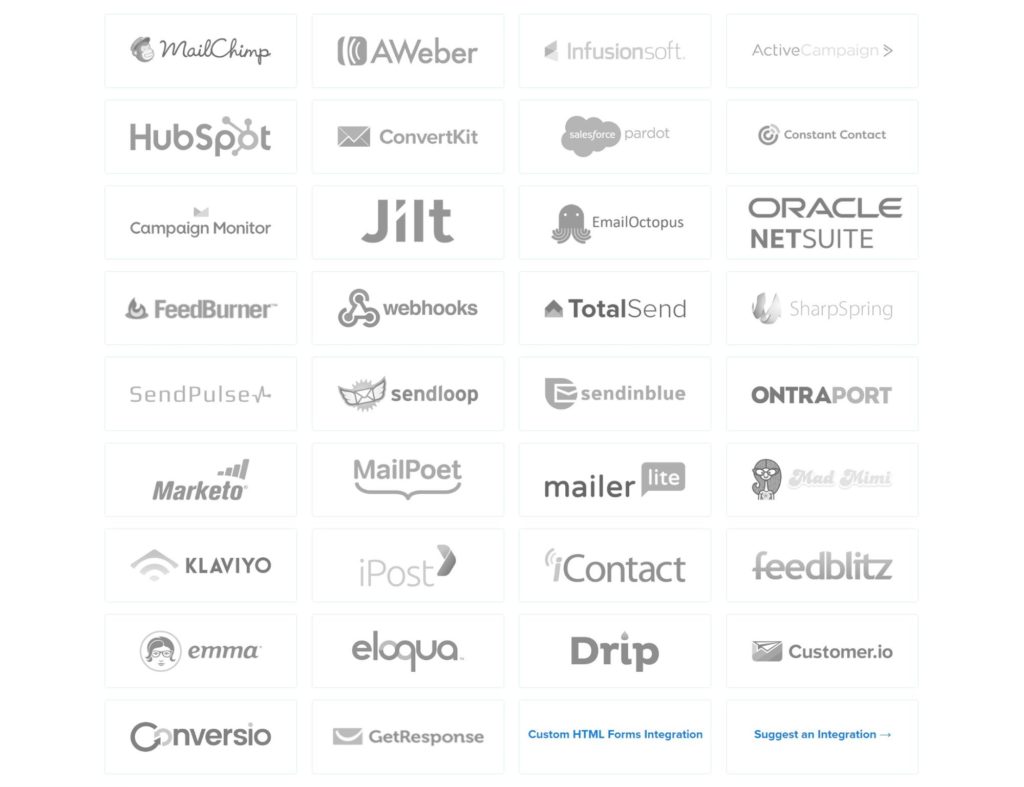
If your tool isn’t on that list, OptinMonster also has a catch-all Zapier integration that lets you connect to the thousands of apps on Zapier.
Bloom
Bloom currently integrates with 19 popular email marketing services and CRMs — you can view the list below:
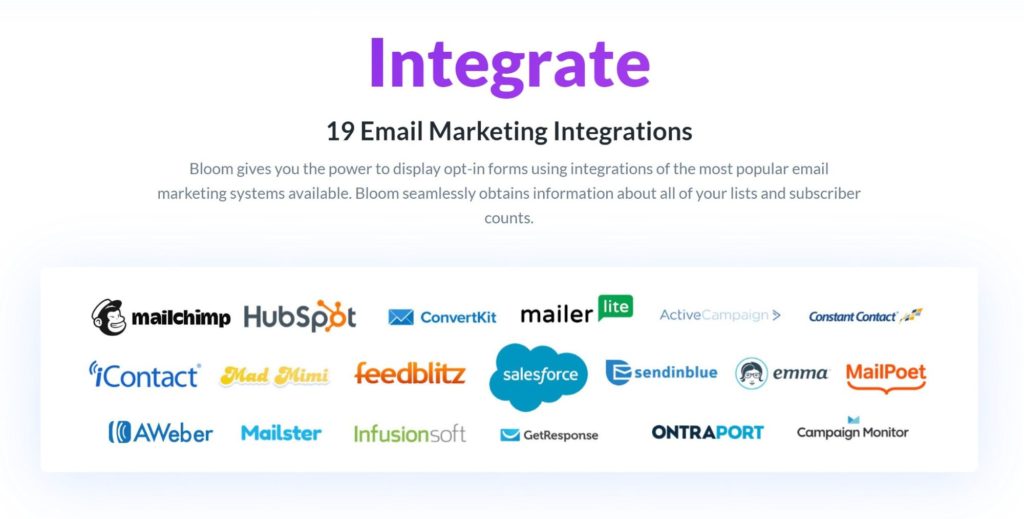
Unlike OptinMonster, Bloom doesn’t have a Zapier integration, so you’re limited to the dedicated integrations.
🏆 Winner: OptinMonster. Simply put, OptinMonster has more built-in integrations, as well as the catch-all Zapier integration. Of course, having lots of integrations isn’t important by itself, because all you need is the one integration for the tool you use. So, if Bloom does offer that integration, there’s really no advantage to OptinMonster.
Pricing
In terms of pricing, Bloom is definitely the more affordable option, especially if you need an opt-in tool for multiple sites. It’s really not even close.
So far, OptinMonster has been dominating a lot of the comparisons, but this is where the bill comes due and you realize why OptinMonster is able to offer such advanced features.
OptinMonster
Because it’s a SaaS tool, OptinMonster uses recurring billing. That is, you need to keep your membership active for as long as you want to use OptinMonster. If you ever stop paying, your forms will stop working.
OptinMonster offers four different pricing tiers. Each tier has different features, as well as different limits when it comes to the number of pageviews it supports and how many sites you can use OptinMonster on.
You can view the full pricing below, but keep in mind that, while OptinMonster quotes monthly prices, you need to pay annually:
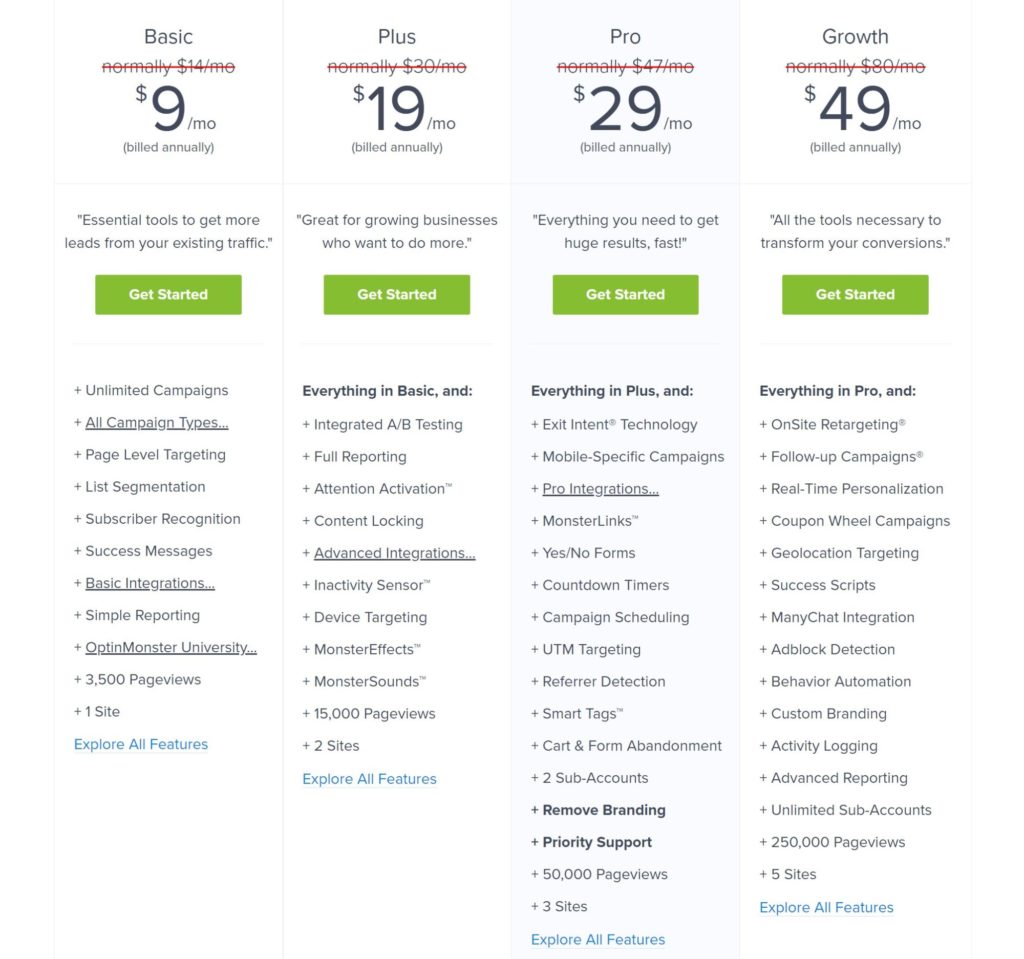
It’s important to note that the cheaper OptinMonster plan does not include many of the features we talked about above. For example, the Basic plan lacks A/B testing, many targeting and trigger rules, and so on. This plan doesn’t even include device targeting (mobile vs desktop), which is a pretty essential feature for popups.
In fact, I’d say that the Basic OptinMonster plan may even be less functional than Bloom, and you don’t start really getting those differentiating features until you get to the Pro plan.
Finally, note that OptinMonster’s promo prices only apply to your first year. After that, you’ll pay the full renewal price. For example, the Basic plan costs $108 for your first year ($9 a month), but renews at $168 a year ($14 a month).
Bloom
Bloom has much more generous and affordable pricing.
First off, there are no limits on websites or pageviews. You can always use Bloom on unlimited websites and unlimited views. Additionally, all of Bloom’s pricing options include every single feature.
Bloom also uses regular WordPress billing, which means the plugin will continue to work even if you stop renewing your license (you just won’t get access to updates anymore).
Finally, remember that paying for Bloom involves joining the Elegant Themes membership, which also gets you access to all of the other Elegant Themes products, such as the Divi theme/plugin. If you’re going to use those products, this adds even more value to Bloom.
To join the Elegant Themes membership, you have two options:
- One-year membership — $89 for one year of support/updates. Bloom will keep working after that first year, but you’ll need to pay again to continue receiving new updates.
- Lifetime membership — $249 one time for lifetime support and updates. Pay once to have an email opt-in tool forever (and all of the new updates).
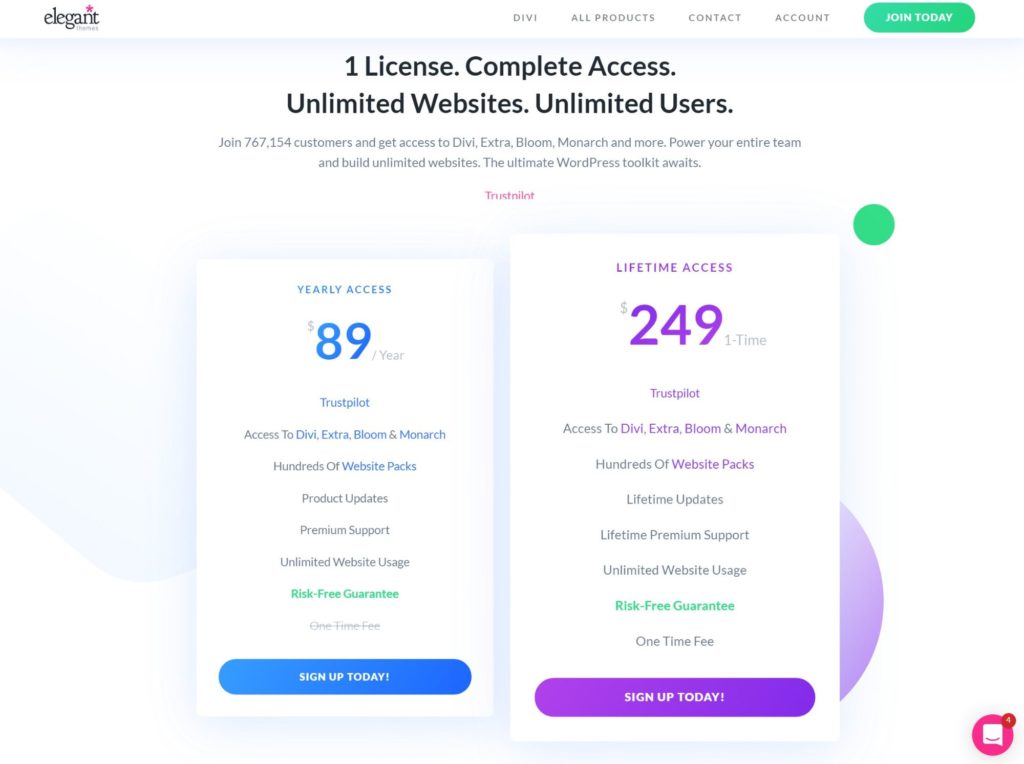
🏆 Winner: Bloom. Bloom is way cheaper than OptinMonster, especially for multiple sites and/or high-traffic sites.
Should You Use OptinMonster or Bloom?
Overall, I think both of these tools have their place — it’s really just about picking the right tool for your situation.
If you ask me to recommend the ‘best’ plugin without taking the price differences into account, it would definitely be OptinMonster. OptinMonster is just a lot more flexible and lets you implement more advanced marketing strategies. You get the visual drag-and-drop editor and, more importantly, you also get a much more advanced set of targeting rules, especially for eCommerce stores.
Of course, the downside is that it’s a lot more expensive, especially if you need to use it on multiple sites. Additionally, not everyone needs those advanced personalization/targeting rules.
For example, if you just want to create a few email opt-in popups that you display site-wide or maybe targeted to specific categories of blog posts, then you don’t really need the extra power OptinMonster offers, and Bloom can already do everything you want.
So, here are my recommendations:
When to Use Bloom
Overall, I think Bloom is probably the best fit for what most regular WordPress users are looking for in an email opt-in tool.
If you just want to create a few opt-in popups or forms and you aren’t going to get really into personalizing your offers with user-specific targeting rules, you should go with Bloom.
No, it’s not as feature-rich as OptinMonster, but it does have some advantages in that it’s very easy to use (because it’s less complex) and it’s also a lot cheaper than OptinMonster, especially if you need to use it on multiple sites.
You’ll also still get access to useful features, such as A/B testing, which are only available on the higher-tier OptinMonster plans.
When to Use OptinMonster
On the other hand, if you want to really get into personalization as a marketing strategy, then OptinMonster is definitely the best tool for the job. You can create different opt-ins for different types of visitors and target them based on referring sources, user location, new vs. returning visitors, and lots more. It’s definitely more work to set up those targeted offers, but they can be a great way to boost your conversion rates.
OptinMonster is also the best option for eCommerce stores, as it has lots of eCommerce-specific features that Bloom doesn’t offer. Being able to target offers based on conditions such as the items in a shopper’s cart or the total value of a shopper’s cart is very valuable.
Basically, OptinMonster is the winner for serious marketers who are going to take advantage of its advanced feature list.
Remember, though, that you don’t start really getting the differentiating features until you get up to the OptinMonster Pro plan, so you should expect to invest at least ~$350 a year if you want to go the OptinMonster route.
Or, if I were to throw a third option into the mix, I’d say to also consider Convert Pro, which sits kind of in between Bloom and OptinMonster in terms of its features and pricing.
Related Reading:
Used/using Bloom or OptinMonster? Thoughts and experiences with each?
Discover more from WPMarmalade
Subscribe to get the latest posts sent to your email.

